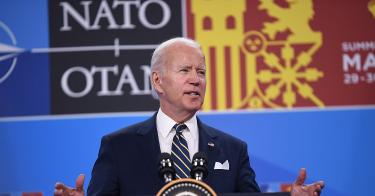At this month’s NATO summit in Vilnius, Lithuania, the organization must answer a fundamental question: Will it actually focus on collective defense? NATO nations promised to do so a year ago at the summit in Madrid. It has become clear that the answer to that question is, ultimately, a political one.
In Madrid, NATO shook off its Russia blinders, naming Moscow “the most significant and direct threat” to peace in Europe. All members agreed to a raft of long overdue measures to bolster deterrence. Since then, military leaders and the NATO officials have worked hard developing plans to make heightened deterrence a reality. At Vilnius, the political leaders will have to decide if they have the stomach to make the long-term investments in defense necessary to ensure peace.
Greater investment—by every NATO member—is essential if the alliance transition is to transition from one that seeks to deter through punishment to one which can deter by denial. The U.S. should work diligently to ensure to that each member does its part to make that transition a reality.
Russia’s 2022 invasion of Ukraine jolted many European policymakers to recognize that it takes tanks on the ground—not words on paper—to deter Putin. The subsequent sober inventory of their own military capabilities left many allies with the realization that, while the emperor still had clothes, they were largely threadbare. They were further unsettled when the daily expenditure rates of ammunition and other materiel by Ukrainian and Russian forces revealed that their own stockpiles—and their production capacity—were woefully lacking.
>>> Ahead of 2023 NATO Summit, U.S. Policy in Europe Must Advance Prosperity and Security
These shocks seemed to have had a salubrious effect. Shortly after Russia’s 2022 invasion, Germany announced a €100 billion military modernization fund—something that would have been unthinkable a month prior. Next week, Berlin is expected to pledge to spend 2% of GDP on defense. At last.
The United Kingdom (which already spends the NATO target of 2% of GDP on defense), and France (which spends just below 2%) announced major defense spending increases earlier this year. Many nations that retain a longer horizon for attaining 2% have announced significant increases to get there. Just last week, Denmark announced it would triple defense spending over the next decade. Italian Prime Minister Giorgia Meloni has promised significant budget increases for the military, explaining, “Freedom has a price.”
Three camps have emerged on defense spending: allies like Denmark and Germany are putting teeth into hitherto vague promises to attain NATO spending targets at an either indeterminate or variable future date.
Other nations (primarily in eastern Europe, where the danger posed by Russia is felt most acutely), already meeting NATO benchmarks, are supercharging their investments. Poland, for example, plans to raise defense spending this year to 4% of GDP, a rate even higher even than the U.S. Similarly, the Baltic States and Romania are increasing their defense investments beyond 2%. These nations are pushing for the current NATO investment benchmarks to be viewed as a floor rather than a ceiling.
The final group of allies continues to fail to make the sort of investments everyone now knows are necessary. Countries like Belgium, Canada, and Spain have yet to decisively turn the corner on defense.
Having every member state live up to its Article III treaty commitments to “maintain and develop their individual and collective capacity to resist armed attack,” is the bedrock upon which transatlantic peace and prosperity is built. The Vilnius summit must assure that the positive trend toward increased capabilities continues, but with greater urgency and alliance-wide adoption.
To this end, the U.S. must work hard, cajoling and pulling allies to take the political decision to fulfill their obligations and invest in defense. Regrettably, under President Biden, the U.S. has eroded its standing to push this agenda by enacting defense budgets which amount to de facto cuts. This makes the job harder, but not impossible.
But while adequate investment is essential to successful deterrence, it is not—in and of itself—sufficient. Also needed are planning, exercising, and staging alliance capacities in a way to truly defend every bit of NATO territory. Thankfully, this is being done. One senior NATO official recently described to me that the alliance “is undertaking the biggest overhaul of its military structures since 1949.”
The alliance adopted a new strategic concept last summer. It is currently reworking its regional defense plans to align with that document, as well as the guidance contained within the 2019 NATO Military Strategy. A key test in Vilnius is to gain political approval for three new regional defense plans.
>>> Forging the Future of NATO
Similarly, NATO’s New Force Model, announced last year, would expand NATO’s Rapid Reaction forces from 40,000 to 300,000. Obviously, this will require new investments to keep forces and equipment at a high state of readiness.
For now, the model is mostly a paper conception. NATO is having to relearn the lessons of how to generate, maintain and swiftly move large numbers of fully equipped standing forces to appropriate battlefields. The logistics problem, for one, is painfully evident. Last November, French tanks traveling through Germany to exercises in Romania were denied transit because their weight exceeded German regulations. Once inside Romania, those same tanks had to take a circuitous route to get to their base because a key bridge was closed for repairs.
It is simply unconscionable that NATO could lose a town or innocent lives because paperwork isn’t in order, or a bridge is too small. Fixing the logistics piece of the puzzle will likewise require the political will to invest in solutions that will not come cheap.
The Russian war against Ukraine has underscored the importance of NATO. Ultimately, the alliance is made real only through the possession of actual capabilities, aircraft, artillery, ships, and soldiers. NATO is now coordinating and planning for collective defense in a way unseen since the end of the Cold War, but these efforts must be more than mere promises in the air or plans on paper.
Vilnius must be the investment summit. NATO’s 31 political leaders should find the political fortitude and courage today to safeguard tomorrow.
This piece originally appeared in RealClear Defense


